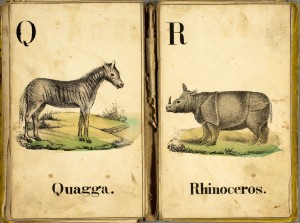The quagga illustrated in this children’s book caught my eye because, possibly like you, dear reader, I had never heard of this animal. And so I went to Wikipedia where I read an interesting article about the quagga’s relationship to the plains zebra and about efforts to breed them back into existence. Curator of Children’s Literature Laura Wasowicz describes the book in which this image is found.

Alphabet of Natural History. Hartford: D.W. Kellogg & Co., [ca. 1830-1842]
This fragile accordion-fold format picture book depicts exotic animals, many of which would have been described in African travel narratives that were published in the antebellum era. The image presented here shows the rhinoceros familiar to modern readers, and the exotic quagga, a zebra-like animal that became extinct in the late nineteenth century. The Kellogg brothers (Daniel Wright, Edmund Burke, and Elijah Chapman Kellogg) were prolific publishers of high quality lithographed prints and children’s books for nearly four decades. Purchased from Michael Burstein. General Library Acquisitions II Fund.

Both the spectacular rhino and the uniquely stripped quagga made their American debut in the early 1830s—the same time period as Kellogg’s Alphabet of Natural History—and would have been widely seen in several itinerant menageries as they traveled every night to appear in a new town under a canvas pavilion.
Showman Zebedee Macomber imported the first quagga to the US in July 1833, part of a large shipment of exotic animals he brought over from Africa for the traveling menagerie of Purdy, Welch, Macomber. Macomber soon returned to Africa to import 70 more animals and birds on the ship Susan, including four more quaggas. With the ship’s return in May 1834, the partners had three menageries on the road moving daily. Macomber again headed to Africa for more animals but before his return, the 16 animal shows on tour in 1834 all merged to create a monopoly called the Zoological Institute that merged into 13 different menageries for the traveling season of 1835. When Macomber finally returned to Boston in May 1835 his latest importations were divided among the several shows. The Zoological Institute ultimately failed with the Panic of 1837. One of these quaggas is pictured on a magnificent poster (more than 9 feet high by over 6 feet wide!) at the AAS for the traveling Zoological Institute branch that was based in New York. The same poster features a 6-foot wide woodcut of a rhinoceros in a cage pulled by six horses.
The first living rhino (at least one died on shipboard before arrival and was stuffed and exhibited in the late 1820s) arrived May 1830 and traveled for a time without other animals, so spectacular was its appearance. In 1831 it joined the American National Caravan of June, Titus, & Angevine and is featured on another fine and large poster for that year at AAS that is almost 6 feet high by 3 feet wide. Five months later another rhino arrived and was auctioned in January 1831. It was with the New and Rare Collection of Living Animals operated by Raymond & Ogden at least through 1833.
While common on the plains of Africa at the time, the quagga was hunted to extinction and the last specimen died in the Amsterdam zoo in 1883. Most of the 5 rhino species are endangered today, in one case with only a few dozen alive.
Thank you for your truly informative post!